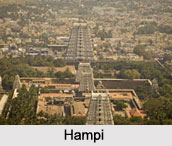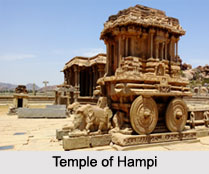 Hampi, now in Bellary District, was the royal capital of Vijayanagara Empire. It is rightfully recognised as the domain of artistically carved temples with magnificent architectural monuments and creations.
Hampi, now in Bellary District, was the royal capital of Vijayanagara Empire. It is rightfully recognised as the domain of artistically carved temples with magnificent architectural monuments and creations.
Location of Hampi
Hampi is situated on the banks of Tungabhadra River. Hampi is the abode of the remnants of the Vijayanagara Empire. It is decorated with the ancient monuments of South India, with excellence of art and architecture. Hampi in modern India stands lonely as the architecturp[al specimen of Lord Vishwakarma in earth. Hampi is located in the central part of the state of Karnataka. It is 353 km from Bengaluru and 13 km from Hospet. This location was the obvious choice for the capital of the empire, as it is naturally fortified and protected on all sides; in the north by the mighty Tungabhadra River and on the other three sides by steep, rocky mountain with massive boulders of granite. 
History of Hampi
History of Hampi depicts that the Vijayanagara kingdom was ruled by three dynasties namely Sangama dynasty (AD 1336-1485), Saluva dynasty (AD 1485-1505) and Tuluva dynasty (AD 1505-1570) up to AD 1565.
Temples in Hampi
Hampi displays a variation from this layout of centralized temple of medieval art and architecture with outlying ancillaries. Religious buildings are scattered about in small units, each with its own importance and function. Perhaps one of the reasons for this change was the terrain of the area, with the plan of the city following the lay of the land. The art and architecture of the temple is based on the traditional Hindu style - each temple typically has a sanctum, a passage, an antechamber, and pillared hall and a "kalyana mandapa" (marriage hall). 
Art and Architecture of Hampi
Vijayanagara style of architecture is based on the availability and the usage of natural resources, namely granite, which was the material used primarily by the Sangama dynasty. Later dynasties had employed the schist-rock, which were suitable for complicated carvings. Many of the palaces have long since disappeared, as the kings used wood and bricks in their construction. Some brickwork is still visible on the gates to the temple courtyards.
Stone Carvings of Hampi
The stone carvings of Hampi played an important role in maintaining the records of the erection of the temples. The rulers of Hampi were the great patrons of sculpture and ethnicity and promoted the expansion of architectural and sculptural side of Hampi during their reigning period.
Tourism in Hampi
Tourism in Hampi encompasses paying visit to the marvelous temples and monuments that are the evidences of creative and artistic excellence. The Hampi Bazaar a long street 32 metres wide and nearly 728 metres long, runs between Virupaksha Temple and the foot of the Matanga Hill and was once lined with magnificent houses and beautiful mandapas. Virupaksha Temple is located near the Hampi Bazaar. Another celebrated temple of Hampi is the Vitthala temple, which shows its reflections to the tourists in art and architecture of rock cut sculpture formation. This temple is located near the Tungabhadra River. Vitthala temple is measured as the most decorated form in Vijayanagara temples.



















